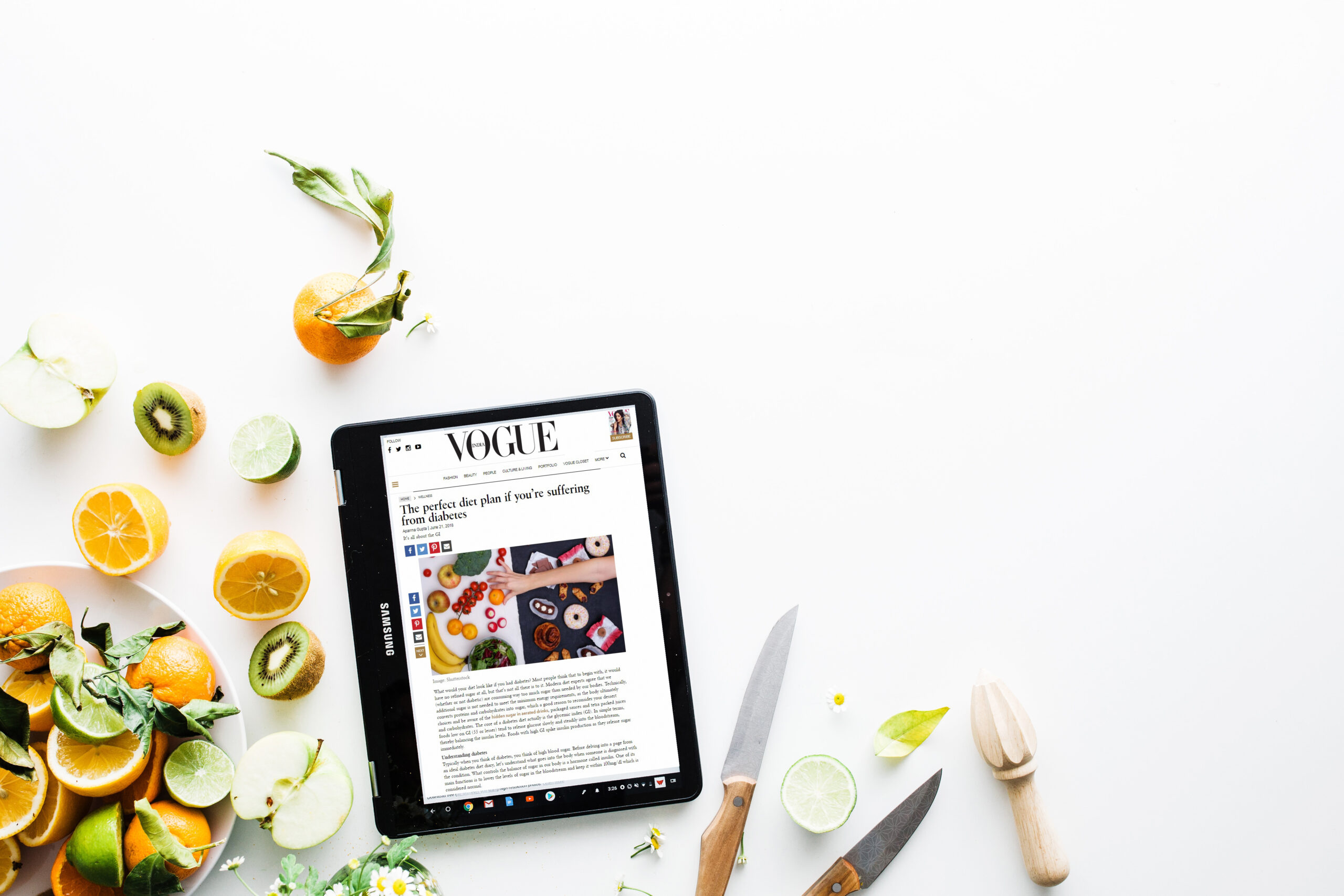What would your diet look like if you had diabetes? Most people think that to begin with, it would have no refined sugar at all, but that’s not all there is to it. It’s all about the GI…
Modern diet experts agree that we (whether or not diabetic) are consuming way too much sugar than needed by our bodies. Technically, additional sugar is not needed to meet the minimum energy requirements, as the body ultimately converts proteins and carbohydrates into sugar, which a good reason to reconsider your dessert choices and be aware of the hidden sugar in aerated drinks, packaged sauces and tetra packed juices and carbohydrates. The core of a diabetes diet actually is the glycemic index (GI). In simple terms, foods low on GI (55 or lesser) tend to release glucose slowly and steadily into the bloodstream, thereby balancing the insulin levels. Foods with high GI spike insulin production as they release sugar immediately.
Understanding diabetes
Typically when you think of diabetes, you think of high blood sugar. Before delving into a page from an ideal diabetes diet diary, let’s understand what goes into the body when someone is diagnosed with the condition. What controls the balance of sugar in our body is a hormone called insulin. One of its main functions is to lower the levels of sugar in the bloodstream and keep it within 100mg/dl which is considered normal.
Sometimes, there is insulin deficiency or a state where insulin is not used well. In pre-diabetic stage or insulin-resistance, you have a situation where your body is producing so much insulin that it causes your cells to ignore it. A rise in insulin comes after a carb-rich meal or a meal that’s high in GI. Eat refined carbs or sugar and you will spike insulin production. As the concentration of sugar increases beyond 100mg/dl, the rate of insulin production rises exponentially. “Anything that you see bearing the words ‘lite’ or ‘skimmed’ or ‘low-fat’ is best avoided as they lower the fat and replace it with carbohydrates. On its own, fat is not bad for the body, in fact, it is needed. If you are watching your weight, you might want to go on a low-fat diet but if you are a diabetic, you need the fat to be able to heal the entire system,” educates US-based Dr Eric Berg, a chiropractor who specialises in weight loss through nutritional methods, on his hugely popular videos. He questions the approach that says that you need to be on life-long medication. He believes diabetes can be stabilised, but you have to change the way you eat.
The diet plan for those dealing with diabetes
There are three main types of food—fats, proteins and carbohydrates. The right amount of protein will not increase insulin, and fat definitely doesn’t increase insulin on its own. A nutrient-rich but low-carb diet works best for most of us, especially those diagnosed with diabetes. So, the focus of a diabetic diet should not be just on GI values but preparing meals with low GI load. Instead of working on deprivations, look for options, is what Delhi-based nutrition consultant Sangeeta Khanna believes in. For instance, you don’t have to banish pasta from your diet. Have a pasta, but team it with a fresh salad instead of a greasy and cheesy portion of garlic bread.
Ghee is making a comeback and with a bang. It is now recognised as one of the healthier fats. A tiny dollop of ghee with your paratha or as tadka in dal can balance the GI load of the meal. So, to keep the calorific value in check, instead of limiting the use of ghee, practice portion control. Go for that paratha topped with ghee or white butter but stop at one. “Good fats are essential, carbohydrates should be limited and should always come from complex carbohydrate sources like millets, whole grains, vegetables and whole fruits. Refined sugar is a complete no-no but alternate desserts can be made with fruits and hung yoghurt made without any added sugar. Dried fruits like apricots and prunes can be had in small servings,” says Khanna.
It is all about glycemic index, agrees Dr Siddhant Bhargava, co-founder and nutritionist of Food Darzee, a health food delivery service. When his team customises diets for diabetics, they ensure that the meals don’t spike blood glucose levels because a diabetic’s system is incapable of utilising this spike efficiently. “Fats rich in omega 3 (DHA and EPA) such as fish oil and flax seed oil (buy here) are a must to prevent any cardiovascular degeneration in the future. About 20 per cent of daily calories should come from protein (unless there is advanced renal damage where a low protein diet is recommended),” adds Bhargava.
Food that has bitter taste is good for diabetes according to the tenets of Ayurveda, informs Gita Ramesh, joint managing director at Kairali Ayurvedic Group. Karela or bitter gourd tops the list. “Consume fresh food (as soon as it is cooked). Avoid that which is overcooked or deep fried,” adds Ramesh, who has also authored the Ayurvedic Cookbook. With these basics in mind, we have put together a complete plan to help you with your daily, diabetic-healthy diet.
AM infusions
“Boil fenugreek powder (buy here) and turmeric powder (buy here) in milk and this can be had every day in the morning. Bitter gourd juice or amla juice also make for some therapeutic morning drinks for diabetics,” states Ramesh.
Breakfast for diabetics
A typical breakfast as part of a diabetic diet could comprise of two whole eggs cooked in olive oil/ avocado oil with a slice of brown bread or some steel cut oats (buy here) or porridge, recommends Bhargava. While that is ideal for daily nutrition, if you have a savoury tooth, then there are other options too. “Besan cheela (savoury gram flour pancakes), multigrain or mixed grain poha, chickpeas or paneer in any form can be taken with one roti, preferably multigrain. Buttermilk is a good accompaniment with these,” says Khanna who believes that taste should never be compromised on even in healthy or “diet” dishes. A dash of lemon juice or a garnish of fresh herbs can add life in any dish.
The perfect lunch options for diabetics
Prepare each meal keeping in mind the glycemic load. Fill up your plate with vegetables and let the bread be on the side. The thumb rule is to have more of sabzi and dal, and less of roti and rice. One roti or 2-3 tablespoon of cooked rice should suffice. Avoid white rice, wheat flour and refined flours. Instead, switch to brown rice and all varieties of millets (bajra/jowar/ragi). Paneer or tofu are good sources of proteins. Khanna allows eggs and fish, chicken and even red meats but in small portions. Yoghurt is great; milk not so much, she adds.
What to eat for dinner, if you have diabetes
Dinner should be similar to lunch with vegetables, lean meats and complex carbohydrates but should consist of more fibre. Bhargava suggests adding some probiotic curd on the side to keep your gut in good shape. For days that you are yearning for some meal in a bowl dinner, go for a barley soup loaded with finely chopped vegetables. “Barley in any form such as soups, porridges and pancakes is very healing for diabetes,” affirms Ramesh.
Mid-meal snacking
Eat fruits as a whole and not in juice forms as the fibre in the fruit will help in proper digestion. Fruits like apple, pear, orange, jackfruits, pomegranate, guava and papaya make for some healthy snacking options.
What to eat out when you have diabetes
Eating out is not too tricky for diabetics. “They just need to refrain from refined flours and sugars. Care needs to be taken in enquiring whether a dish has added sugar (as a lot of dishes do in some form). Otherwise, most dishes can be ordered,” states Dr Bhargava. Cold pasta salads are better than hot pasta dishes for a diabetic, informs Khanna and adds it’s all about balance. “A small portion of biryani can be balanced with some salad and lots of raita. Restrict the portion of tandoori whole wheat roti to half as you enjoy it with some chicken curry or masala paneer.”
Workout plan for diabetics
Exercise is very essential to control blood sugar and to manage weight. “The best exercise for a Type 2 or Type 1 diabetic is low volume HIIT (high-intensity interval training) followed by low-intensity cardio for 20 to 30 minutes to bring a balance in the insulin levels post workout. Before a diabetic starts or resumes an exercise program, he/she should monitor the sugar levels before and after the exercise to ensure that the exercise plan is working in his favour,” advises Arun Selvakumar, fitness manager and head coach at Nitrro Bespoke Fitness. Avoid overtraining to keep stress hormones like cortisol and adrenaline down.
Disclaimer: This article is not intended to be a substitute for professional medical advice. Please consult a doctor before making any changes to your diet, especially if you’re on medication.

This article was first published in vogue.in





